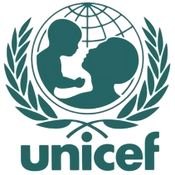UNICEF
Version vom 14. November 2019, 21:43 Uhr von WikiAdmin (Diskussion | Beiträge)
(Dieser Artikel wurde noch nicht aus dem Englischen übersetzt oder enthält noch englische Textpassagen. Bitte beziehe dich vorerst auf die Informationen im englischen Artikel. Klicke dazu in der IntactiWiki-Navigation im Abschnitt "In anderen Sprachen" auf "English".)
 | |
| Deputy Director: | |
|---|---|
| Stephen H. Lewis (1995-1999) | |
| Rao Gupta (2011) | |
| Related Organizations: | |
| UNAIDS | |
| World Health Organization |
UNICEF promotes the circumcision of children as HIV prevention policy.[1]
Children & AIDS brochure
| ” | Young people everywhere need accurate and relevant information about sexual and reproductive health and HIV transmission, as well as opportunities to build risk-reduction skills. They also need access to appropriate HIV prevention services, including voluntary counseling and testing, harm reduction, sexual and reproductive health services, PMTCT and male circumcision, and to commodities including condoms. (UNICEF)[2] |
Swaziland
UNAIDS is working with the Swaziland Ministry of Health to introduce and scale up neonatal circumcision.[3]
Point of Interest: In recent studies, HIV transmission was found to be more prevalent in circumcised males in Swaziland. The drive to circumcise the majority of Swazi men continues none the less.[4]
Einzelnachweise
- ↑

Eastern and Southern Africa: Medical male circumcision
, UNICEF. Abgerufen 29. April 2011.
Zitat:[...] the Government and UNICEF are working together to introduce infant male circumcision [...]
- ↑ Key Messages of Chapter 3. Children and AIDS. pg.15 (2008)
- ↑
 Mazzotta, Meredith (4. März 2011)."Swaziland embarks on ambitious plan to circumcise 80 percent of men 18 to 49 this year", Science Speaks: HIV & TB News. Abgerufen 6. Mai 2011. "The Ministry of Health, supported principally by UNICEF and PEPFAR, is currently working to introduce and scale up neonatal circumcision."
Mazzotta, Meredith (4. März 2011)."Swaziland embarks on ambitious plan to circumcise 80 percent of men 18 to 49 this year", Science Speaks: HIV & TB News. Abgerufen 6. Mai 2011. "The Ministry of Health, supported principally by UNICEF and PEPFAR, is currently working to introduce and scale up neonatal circumcision."
- ↑
 Swaziland Demographic and Health Survey 2006-07. Mbabane, Swaziland: Central Statistical Office and Macro International Inc.. 2008; Abgerufen am 6. Mai 2011.
Swaziland Demographic and Health Survey 2006-07. Mbabane, Swaziland: Central Statistical Office and Macro International Inc.. 2008; Abgerufen am 6. Mai 2011.
Zitat:As Table 14.10 shows, the relationship between HIV prevalence and circumcision status is not in the expected direction. Circumcised men have a slightly higher HIV infection rate than men who are not circumcised (22 percent compared with 20 percent)